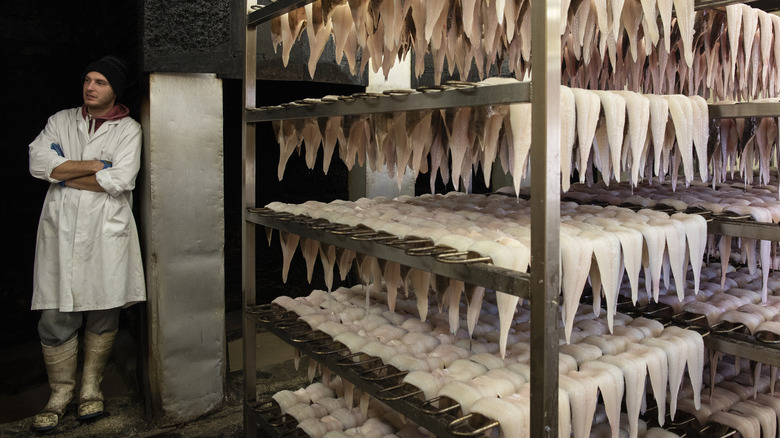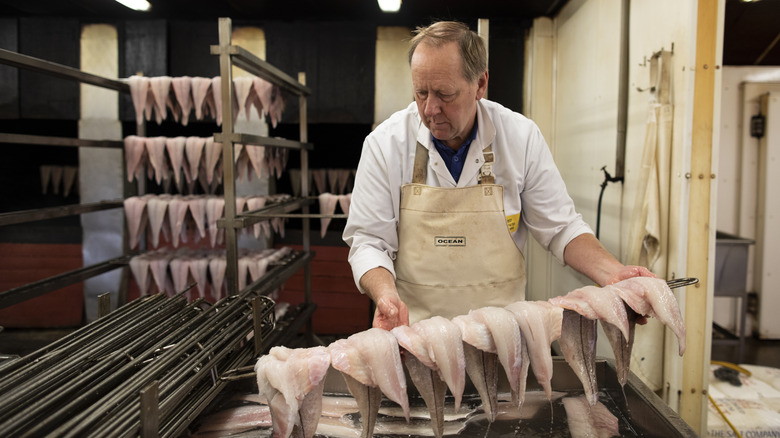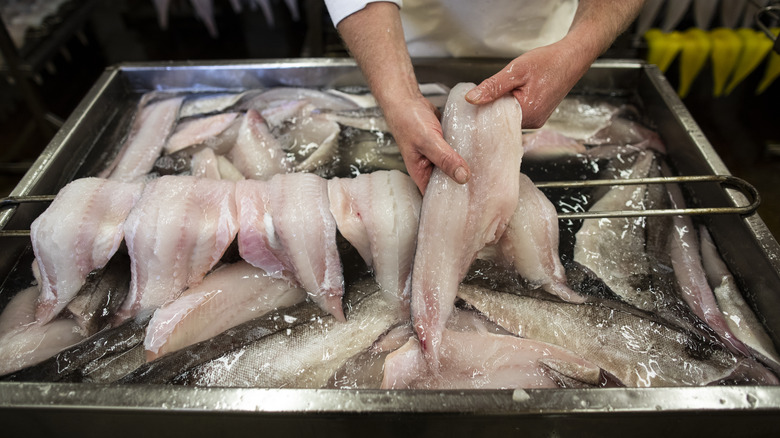What Is Grimsby Smoked Fish And Why Is It So Rare?
For those familiar with England's prospering culinary scene, you may know that the ports around the country reel in some of the finest fish in the world. The island sits on fish-rich waters, allowing them to produce some of the best fresh seafood available. Whether you're in Northern coastal areas or experiencing the Southern regions, there's plenty to indulge in. As England's Coast notes, Yorkshire and Northumberland, two Northern counties, produce tasty kippers, an English breakfast staple, made from fresh herring. Norfolk is teeming with Cromer Crab, and fresh oysters are harvested from Mersea Island in Essex.
But, it may just be the seaport of Grimsby, England that doles out some of the most rare and mouthwatering fish in the world. Here, you can partake in cold-smoked and hand-cut cod, salmon, and haddock. The practice of cold-smoking fish has largely died out — but while time consuming, the final result is worth it, and the deliciously salty and smoky flavors are unique to Grimsby. Per Atlas Obscura, only five establishments that utilize this practice remain, thanks to a union created to save their dwindling businesses. The history of the Grimsby smoked fish is rocky, but emerges with one-of-a-kind fish.
History of Grimsby smoked fish
According to Atlas Obscura, in the early 20th century, the town of Grimsby was a bustling fishing port where dozens of smokehouses lined the streets, each one producing delicious cold-smoked fish the traditional way. However, as technological practices grew, such as the introduction of the speedier electric kilns, traditional cold-smoking declined. On top of that, another crisis brewed. The Cod Wars was a famed controversy that took place between England and Iceland between the years of 1958 and 1976. This decades-long battle resulted in England being cut off from Iceland's plentiful waters, and many British fishers couldn't recover.
Today, only a handful traditional smokehouses remain, but they were able to protect themselves by banding together to form a union. As per Slow Food, the Grimsby Traditional Fish Smokers Group (GTFS) comprises five businesses located at the Grimsby Fish Docks. Each works to preserve traditional practices and sustainably source high-quality fish, "which proudly champions Grimsby's historical ties to the fishing industry," as per Slow Food.
The European Union granted the Grimsby smoked fish the Protected Geographical Indication (PGI) in 2009, according to Seafish. This well-known indication will raise consumers' awareness of this delicacy and help further protect and solidify the Grimsby smoked fish as culturally important.
How Grimsby smoked fish is made
According to Seafish, there are three steps behind cold-smoking fish the traditional Grimsby way: brining, smoking, and post-smoking inspection. These methods are hundreds of years old, as per Regal Fish, guaranteeing quality is embedded in these tried-and-true practices. And the smokers themselves also are highly trained and experienced, ensuring they can still create some of the most delectable seafood under varying conditions, such as fluctuating temperatures and differing filet sizes, as per Seafish.
The first step in the process involves the fish being fileted, and then transferred to bathe in a salt solution for around 10 minutes. They are then removed from the water and hung across metal rods to drip off excess liquid. Once sufficiently rested, they are placed in the chimney smokers while still remaining on the rods. While being smoked, however, there are ventilation spots located within the chimney where cold air can find its way in. This cool temperature uniquely mixes with the fish while smoking, hence why the process is called cold-smoking.
The filets are left to smoke overnight, usually smoking for about 12 hours, as per Regal Fish, with a bed of "smoldering sawdust" below, which ensures that the flavor seeps deep into the fish. When finished, the fish are packed and sent off to markets or bulk buyers where they can be mixed into fishcakes and kedgerees, as Atlas Obscura points out.
How to eat Grimsby smoked fish
According to Alfred Enderby, one of the five remaining and protected GTFS producers, some of the smoked fish, like haddock, cannot be eaten raw, and still needs to be cooked thoroughly before it is eaten. The cold-smoke process does not heat the fish enough to bring it to a "ready to eat standard." However, their smoked salmon can be eaten raw, but it can also be cooked and added into salads and pastas or any other dish you see fit, as per the company's recommendation. Grimsby Fish also suggests that smoked salmon filets pair great with a side of mashed potatoes and chive sauce.
Alfred Enderby notes that pan frying is another great method for cooking your smoked fish at home. Really, you can cook Grimsby smoked fish the way you do any other smoked fish. And don't be afraid to get creative.
You can order this rare seafood from many of the five GTFS producers, as Slow Food lists, so if you can't make a trip to England, don't worry. You can still partake in this protected delicacy.



